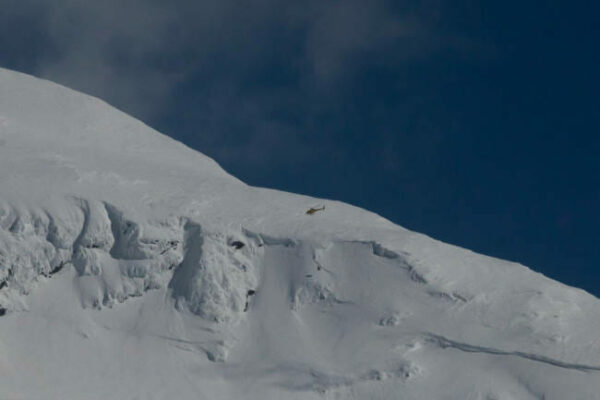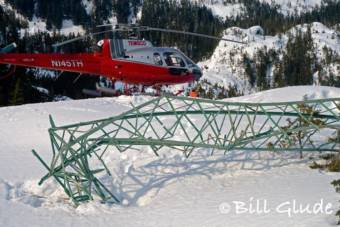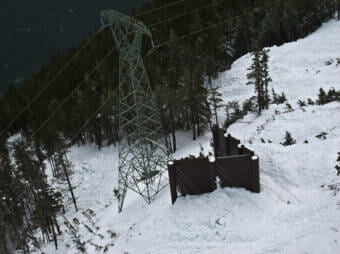
In the spring of 2008, Juneau residents were affected by a huge set of avalanches that wiped out towers for a power transmission line, severing the capital city’s connection to its biggest source of hydroelectricity, the Snettisham Hydroelectric Project.
When the city switched to diesel generators, Juneau residents quickly had to find ways to conserve electricity. Others faced financial hardship with electricity costs that were suddenly 500% higher.
Juneau-based avalanche forecaster Bill Glude says the avalanches on April 16, 2008, were the biggest he’s ever seen — at the absolute top of the scale for size and destruction.
“They did, in fact, gouge the landscape,” he said. “Not only did they remove forests, but they took a lot of the area right down to bedrock, just ripped all the soil out as well. It was pretty impressive. There was a lot of yellow cedar floating out in the arm, big chunks of snow and lots of trees.”
The slides damaged at least two towers and destroyed three others for the main transmission line that runs more than 40 miles to town. Juneau got cut off from its main source of cheap hydroelectric power.

Alaska Electric Light & Power, Juneau’s electric utility, ran diesel generators to meet demand. Back then, the high price of diesel fuel meant the typical household suddenly faced electricity bills that jumped to five times what they were before.
Edward Thomas had just finished a term as president of the Central Council of Tlingit and Haida Indian Tribes of Alaska. He still remembers what tribal citizens were experiencing then, like a friend of his who was afraid of turning up the electric heat in his home.
“He had turned everything down too much. And pipes all froze under his kitchen, then flooded out his whole kitchen,” Thomas said. “And he’s handicapped. So, he had a real traumatic experience with all that stuff.”
People who relied on public assistance programs had to wait before their assistance actually matched their increased electricity costs.
“You’re basically behind by two months by the time the family can make up the difference for what they’re paying and the higher costs,” Thomas said.
He also remembers higher grocery costs and cuts in bus service. Thomas says his family focused on conserving electricity. They turned off unneeded lights, dialed down the electric heat and closed off unoccupied rooms. He says they also disconnected everything that still drew power when it was turned off.
Bruce Botelho was mayor of the City and Borough of Juneau at the time. He was focused on conserving energy in those weeks after the avalanche, too. He stopped using his clothes dryer.
“We got in the habit of draping laundry over banisters to dry out,” he said. “A practice that my wife still does on particularly larger items, sheets and the like.”
Botelho says repairs to the transmission line were expected to take several months, but the city wanted to provide fast relief for residents.
The city took a few quick steps, like suspending sales taxes on the extra surcharge for electricity bills. There were also loan programs for businesses and other relief grants for individuals and organizations.
Electricity powers the city’s wastewater treatment plants and the pumps that deliver freshwater around town. So Botelho says they tried encouraging water conservation, too.
“We estimated that the crisis was going to cost an additional $15,000 a day to maintain Juneau’s water system, with literally 140 miles of pipe,” he said.
As well as the damaged and destroyed towers, over a mile of cable from the transmission line itself was carried down the slope and buried in the snow. Bill Glude says that threatened to pull down even more towers.
“They came up with the thoroughly ingenious method of using a deer hunting rifle from the helicopter to shoot out the glass insulator bells to drop the cables,” he said. “They were able to drop all the cables, take the tension off the towers and save quite a few towers.”
Repairs were finished by June 1, 2008, which was nearly two months after the slides but much earlier than expected.

Glude made several recommendations to the electric utility in the aftermath. Since then, 40-foot tall steel structures were built around some towers to divert snow away from them. And now there’s a state-of-the-art avalanche forecasting and control program.
Glude says the utility is much better equipped now to deal with any potential avalanche hazards along the transmission line.
“Yes, it’s pretty much a night and day difference,” he said.
As part of the avalanche mitigation plan, helicopters hovering over the slopes above the power lines are a common winter sight. Since 2010, the utility has been using a device called a daisy bell that hangs down under the choppers and produces a controlled, targeted blast on the snow.
The city will never be completely safe. Just this winter, a controlled avalanche wiped out a section of those same transmission lines, close to downtown Juneau. Fortunately, the utility had already switched to a set of redundant back-up lines buried in the 1990s under that particular avalanche chute. So this time, residents didn’t even notice.
Matt Miller is a reporter at KTOO in Juneau.




